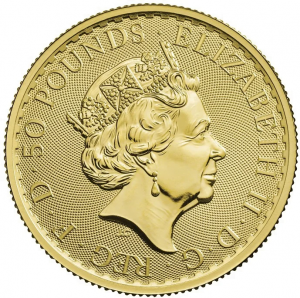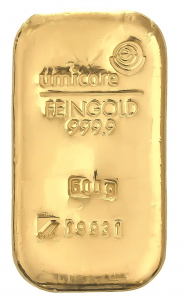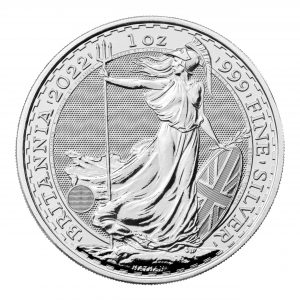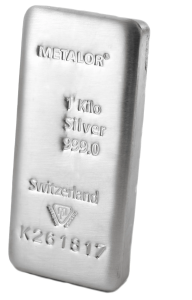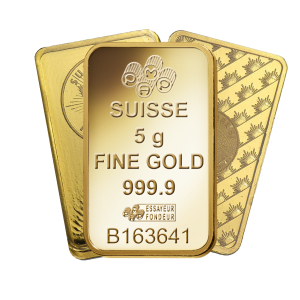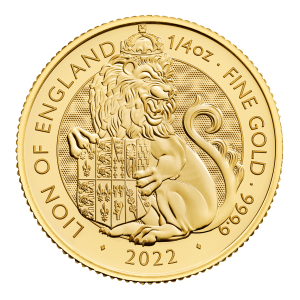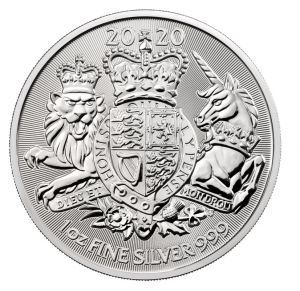Coins are a classic heritage investment. They are popular with numismatics as well as investors looking to purchase them for their gold and silver content. British coins are particularly collectible and are highly sought after by investors. The Royal Mint is one of the most respected and prestigious Mints in the world and has been producing coins for centuries.
Sometimes coins are produced in limited numbers, perhaps to commemorate a certain event or to celebrate a very special occasion. Limited edition coins can be worth large sums of money and due to often being produced in smaller numbers their value has the potential to rise over time.
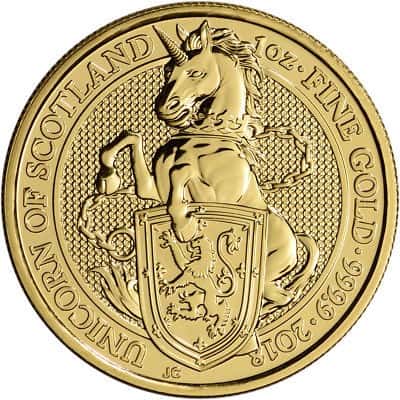
Coins like the 1oz Gold Unicorn Queens Beast are likely to be highly popular in the future
Popular all around the world
British coins are among the most widely collected coins across the globe meaning they are also relatively liquid. As an investor, this can benefit you should you ever need to sell your coins quickly, as there is no shortage of buyers for limited edition British coins.
Discover how to sell your coins at the highest possible price. Download our FREE 10-rule guide here
Historical importance
People who invest in coins for their rarity or collector’s 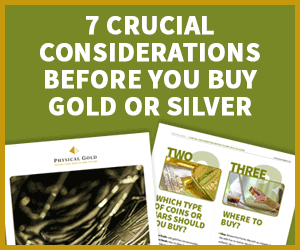
Market Value
Due to the enduring popularity of British coins, their value has been known to fluctuate greatly, meaning there is potential to make a great profit. Some limited editions coins can fetch prices reaching thousands of pounds and their performance can top that of many stocks and shares. Recently the value of many commemorative coins has soared in price. Last year, the Stanley Gibbons GB200 Rare Coin Index, which measures the performance of a representative sample of 200 rare British coins, rose more than 6%. Over the last ten years, the index has risen by an average of 195%.
Design
The Royal Mint has some of the best engravers/designers in the world and some of their coins are stunning to behold. Many limited-edition coins feature a particular design or image that sets them apart from standard circulation coins. For example, a commemorative coin might feature an image that has relevance to that particular event.
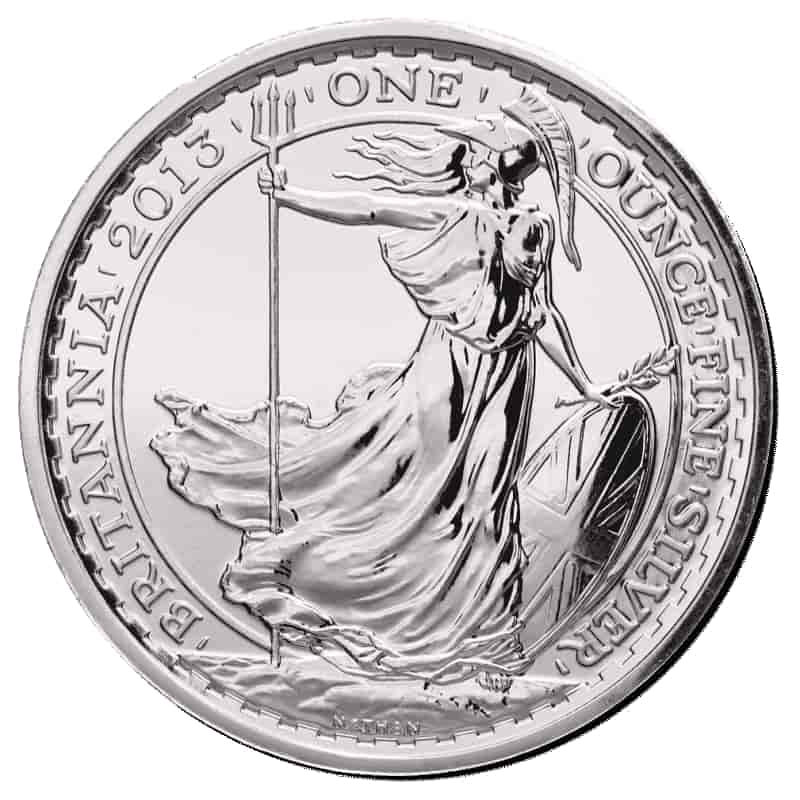
Coins like the Silver Britannia Privy Mark Snake are likely to be popular in the future due to their limited mintage
Gold and Silver Content
Many individuals invest in British Coins because
of their gold and silver content. Up until 1931, British coins were still minted to the gold standard whilst coins containing genuine silver were still in general circulation right up until 1946. Today the Royal Mint still produces gold and silver coins. These are aimed exclusively at investors and include bullion coins such as the Gold Lunar Series. (See below)
The Royal Mint
Coins produced by the Royal Mint tend to have added investment appeal. They are one of the oldest and most established Mints in the world having been producing coins since AD 886. Coins produced by the Royal Mint (such as the Britannia) which qualify as legal tender are also free of capital gains tax when sold.
Invest in limited edition British coins through Physical Gold
Here at Physical Gold, we offer a huge selection of British gold and silver coins, including limited edition gold sovereigns as well as collectable British bullion coins such as Queen’s Beasts and Lunar Coins. To browse our full range of stock, please visit our website, or if you wish to speak to one of our advisers, please call us on 020 7060 9992.
Silver coins were first seen in Britain during Roman times; however, it wasn’t until the creation of the Royal Mint in 1886 that they started being produced on a mass scale. Over the last thousand years or so, the Royal Mint has been responsible for some of the finest examples of silver coinage ever produced and whilst silver is no longer used in the creation of circulation coins, historic British coins still prove to be hugely popular with collectors and investors alike. Silver bullion coins are also still produced by the Royal Mint and are highly sought after by investors who value them for their silver content. Here are some of the most collectable examples of British silver coins:
1) Queen Victoria “Gothic Crown” 1847
The crown was a large and heavy silver coin that remained in circulation between 1707 and 1965. It weighed exactly 1 oz and had a face value of 5 shillings. Silver crowns are incredibly popular with collectors due to their size and relatively high silver content. Pre-1920’s crowns contained exactly .8409 troy ounces of sterling silver (92.5% purity). Thereafter they were produced in 50% silver up until 1946.
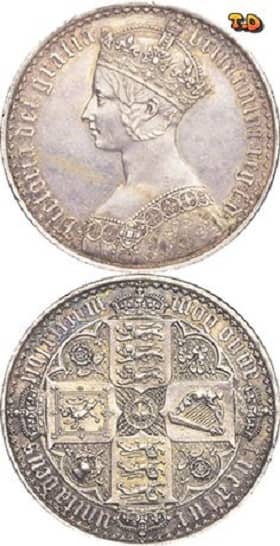
Both sides of the Queen Victoria Gothic Crown of 1847
One of the finest examples of a silver crown is the Queen Victoria “Gothic” crown of 1847. It is considered by some collectors to be one of the most beautiful British coins ever minted. It was also produced in very limited quantities (only 8,000 were ever minted) and its depiction of Queen Victoria wearing a crown meant it was the first coin to feature a crowned monarch for over 200 years.
2) Queen Victoria 1887 Silver Sixpence
From one of the largest silver coins ever produced to one of the smallest; the silver sixpence has become a firm favourite with collectors due to its cultural significance. It was first minted in the reign of Edward VI and circulated until 1980. Over the years it has come to be considered a good luck charm and was often placed in Christmas puddings as a symbol of good luck. Silver sixpences were produced in sterling silver up until 1946 and therefore have a relatively high silver content despite their size. In 1887 Great Britain celebrated Queen Victoria’s Golden Jubilee by issuing a special sixpence to commemorate the event.
3) King Edward VII Silver Florin 1902 – 1910
The florin is a large, thin silver coin that was issued from 1849 right up until 1967. The coin had a value of two shillings and up until 1920 contained exactly.3364 Troy ounces of sterling silver. The Florin was the first-ever example of decimal currency, introduced in Queen Victoria’s reign as an early trial before later being abandoned.
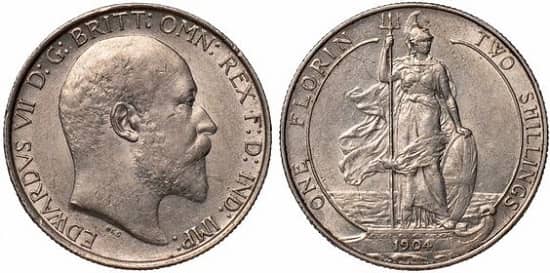
The 1904 King Edward VII Silver Florin
King Edward VII florins are highly prized among 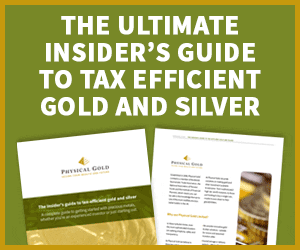
4) William IV Crown 1831 – 1837
William IV coins tend to be very popular with investors as the king only had a relatively brief reign. Consequently, there are fewer coins from this time period still about. During William IV’s reign Crowns were not issued at all for general circulation, however, some proofs and patterns were. These are now highly sought after and can fetch considerable prices. The obverse of this stunning coin features a bare head portrait of William IV whilst the reverse depicts a crowned shield on a mantle.
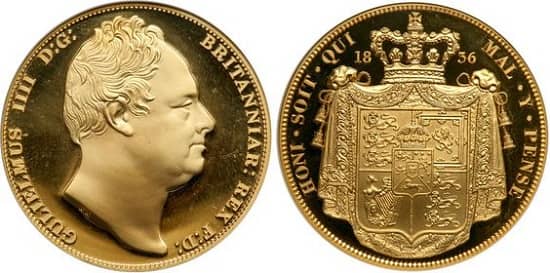
A William IV Crown from 1836
5) George IV Half Crown 1823
Half-crowns were a silver coin equivalent to two shillings and sixpence or one-eighth of a pound. The half-crown was first issued in 1549 during the reign of Edward VI. Pre-1920 half-crowns contained exactly .4206 troy ounces of sterling silver.
One particularly rare and sought-after half-crown is the 1823 George IV half-crown. Its reverse side features a garnished (fancy) shield with a thistle and shamrock positioned on either side. George IV was also the last British king to be shown on coins wearing a Roman-style laurel wreath.
6) Queen Elizabeth II Silver Britannia 2012
Some coins produced by the Royal Mint are 
7) Queen’s Beasts Coins 2016-2021
The Queen’s Beasts are a series of 10 coins produced by the Royal Mint in both gold and silver since 2016. Every year another two coins in the series are released, with the final coins to be released in 2021. Each of the coins in the series features an engraving of one of the 10 heraldic Queen’s Beasts statues that were present at Queen Elizabeth II’s coronation.
The Queen’s Beasts silver coins are a very good option for investors as they are currently the only two-ounce silver bullion coins produced by the Royal Mint. Their stunning designs all of which are created by renowned engraver Jody Clark also makes them a popular choice with collectors. Queen’s Beasts coins are minted in exceptionally fine silver and have a purity of .9999. Browse our selection of Silver Queen’s Beast’s coins here.
8) Silver Lunar coins
Silver Lunar coins are a series of coins produced by the Royal Mint in order to celebrate our multicultural community in the UK. Combining examples of the finest British craftsmanship with ancient Chinese tradition, the Silver Lunar coin was first minted in 2014 and is struck in .999 solid silver. A new lunar coin is launched each year, with each edition set to feature a different animal from the Chinese zodiac. The coin is available in .999 bullion silver. Check out our full range of Silver Lunar coins here.
Buy British silver coins today
Physical gold is one of the leading silver coin dealers in the UK. We offer a huge selection of silver bars and silver bullion coins including some of those already mentioned above. To view our complete range of British Silver coins, please visit our website here. If you wish to discuss a specific item with us or if you need any investment advice, please get in touch by calling us on 020 7060 9992.
Image Credits: Neil David, eBay and Rona Cox
Rare British Coins
British coinage has a unique history dating back to the second century AD when coins were used in trading by Celtic tribes of Britain and Gaul. British coinage became far more regulated after the introduction of the coinage act in 1816 and the standardisation of the pound’s value in terms of gold and silver. In this article, we’ll look at 12 of the most valuable and rare British coins that you’d really wish were in your portfolio.
1. King Edward III Florin – 1344
This rare coin is also known as the double leopard since the coin depicts two leopard heads on either side of the king. Edward III acceded to the throne of England in 1327. Before him, his father Edward II had tried to subjugate the Scots and failed. Therefore, Edward took it upon himself to become a powerful and fearsome ruler to unify the kingdom. He also believed that England could prosper from being a prominent military force in Europe at the time and this coin was his attempt to create a currency that would be used across the continent, bringing much trade across the shores. The 1344 Florin was a coin with great design and appearance, but it failed as it had less gold and was not accepted by the merchants of the time. Today there are only three known coins in existence and in July 2006, it fetched £460,000 at an auction. It is therefore considered to be an extremely rare and valuable British coin. It can be seen on display at the British Museum.
Got gold coins you want to sell? Download our FREE 10 step guide to obtaining the best price here
2. King Charles I Triple Unite
One of the rarest of rare coins of British origin, the coin is a 3-pound piece, which was the highest denomination minted during the hammered coinage era. The coin was introduced during the English civil war and shows the King with a sword, as well as an olive branch. The image is interpreted as the King’s prayer for peace alongside his preparedness for battle. A 1643 triple unite coin was sold for £105,000 in 2016.
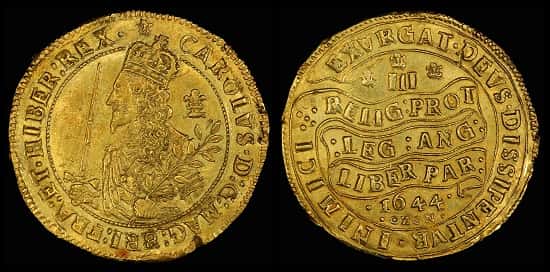
A 1644 version of the Charles I triple unite from the National Numismatic Collection
3. King Charles II petition crown – 1663
At the time of the accession of King Charles II to the throne of England in 1660, the need of the hour was to replace the existing coinage of Oliver Cromwell. A new design was thus created by Thomas Simon, medallist for the King. He made a petition for a new design and presented it to the King. Although the coin was never introduced, it is heralded as one of the finest examples of coin engravings ever made. One of these coins was auctioned in 2007 for £207,000.
4. Queen Anne Vigo five guinea – 1703
Queen Anne took over as the British monarch in 1703 at a time when the Empire was on the path of conquest across the world and her navy ruled the high seas. With a new Monarch in place and Britannia ruling the waves, a new coinage was required. However, at the time the country, in the process of financing global wars, was severely lacking in finance. There was a shortage of gold. The Royal Mint used gold which was captured from the Spanish galleons at the battle of Vigo Bay and minted a 5 guinea coin to commemorate the British victory. Today, there are less than 15 such coins in existence out of the original 20 minted at the time. The coin fetched £296,160 at an auction in 2012 and recently sold for £225,000 in 2016.
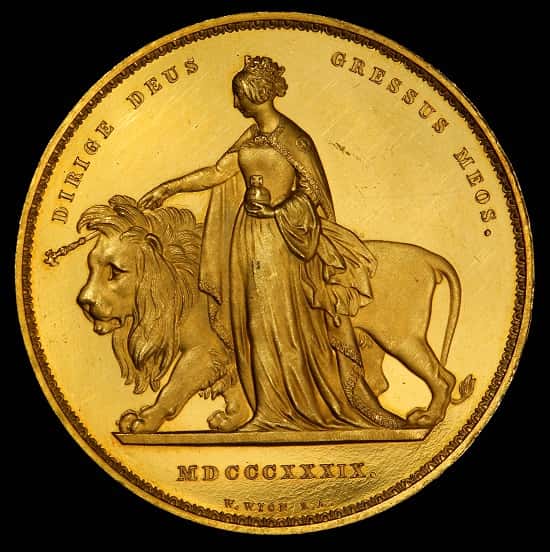
The Queen Victoria 5 pound coin features the artwork of ‘Una and the lion’ on the reverse
5. Queen Anne five guinea – 1706
Queen Anne, who ruled between 1702 and 1714 was the ruling Monarch when the union of England and Scotland happened in 1707 to form Great Britain. The 1706 coin was a new coin minted at the time to reflect the power of the new state. This 5 guinea piece is today considered to be a historic coin of considerable value. It was recently valued at £30,000 at an auction in Baldwin’s.
Learn about “Understanding the gold price per oz” in this Physical Gold Ltd YouTube video.
6. King George III sovereign – 1819
During August to November 1819, the Royal Mint 
7. Queen Victoria five pounds gold coin – 1839
These unique Queen Victoria 5 pound coins feature the motif of ‘Una and the lion’ on the reverse and are considered to be one of the finest British coins in existence. These gold coins are from the Queen’s coronation set. At an auction in 2014, one of these 1839 coins commanded a price of AU$141,000. The auctioneer Baldwin’s of St. James recently set a record new high price for this coin when it sold for £340,000.
8. King George V sovereign London mint – 1917
This gold sovereign was released at the time of the First World War and very few were produced. It had a value of one pound sterling and was in circulation prior to 1932. When the gold standard was lifted, this coin was phased out and due to its limited production numbers at the time, it has become a rarity today. It is valued at approximately £15,000.
9. King George V penny – 1933
Back in 1933, pennies were in abundance,
so the mint decided not to strike anymore. However, the tradition at the time demanded that new pennies should be placed under the foundation stones of new buildings. Due to this reason, the Royal Mint struck around 6 to 7 new coins, some of which ended up under new buildings and the others in the Mint’s collection. The rarity of this coin, therefore, stems from the limited numbers that were produced. These coins were never intended for circulation and today, it is considered to be one of the rarest British coins around, with an approximate value of £72,000.
10. King Edward VIII brass threepence – 1937
The coin is extremely rare as only a few were made by the Royal Mint as a new experimental design. However, before they could go into circulation, the King abdicated the throne to marry American commoner Wallis Simpson. As a result, it is believed that only around 10 were ever struck. The coin is a 12 sided coin with an image of a thrift plant on the reverse. They are highly valued today due to their rarity and auctioneers have set the price at around £30,000.
11. The new two pence coin – 1983
The UK changed its currency system and moved to the decimal system in 1971. After the shift, all 2p coins has the inscription ‘New Pence’ on the reverse of each coin. This practice continued for the next ten years, after which the Royal Mint decided that it was unnecessary to continue the practice any longer. Therefore, in 1982 the words ‘New Pence’ was replaced with ‘Two Pence’. Interestingly, the Royal Mint erroneously produced a limited number of 2p coins in 1983 that had the old inscription. Needless to say, this error created a limited-edition rarity and the coins found their way into the hands of collectors. Each of these coins could well be worth £650 today.
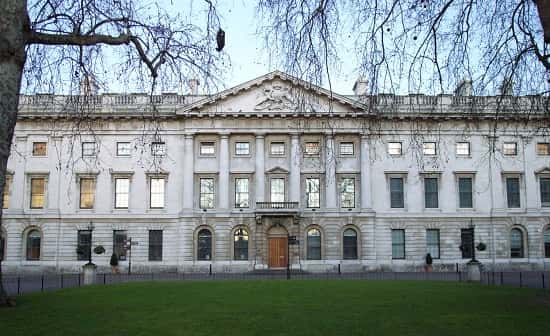
The Royal Mint has been at the heart of British coinage history for centuries
12. London Olympic 50p coin – 2012
The Royal Mint released coins with 29 different designs in order to commemorate the 2012 London Olympiad. As some were released in smaller numbers, they have become rare and command a good price from collectors. One of the rare ones is the original aquatic coin which depicts water passing over the swimmer’s face. Only 600 of this design was ever released. An original coin like this could fetch up to £3,000 according to prices on eBay.
Call our numismatic experts to find out more about valuable British coins
At Physical Gold, our team of numismatic experts can give you invaluable guidance on all kinds of valuable coins. The team has several man-years of experience and are constantly involved in research to ensure that we can guide coin enthusiasts just like you.
Take a look at our website to see some of the great British coins we have on sale. This also includes gold Britannias, silver Britannias, gold Sovereigns, and a variety of other silver coins.
All our products come with a genuineness certificate and a buyback guarantee. Call our team on 020 7060 9992 or drop us a line to find out more about how we can serve you better.
Image credits: Wikimedia Commons, Wikimedia Commons and Wikimedia Commons
The Russian Central Bank plans to strike coins as well as print banknotes in order to commemorate the 2018 World Cup, being hosted in the Russian Federation. Of course, the move to issue the World Cup coin series would be pursuant to approvals being issued by FIFA. As a precursor to the gala event, the Russian Federation has already issued certain coins. For example, a series of coins have been launched by the city of Ekaterinburg, the fourth largest city in Russia, where the last Tsar and the Romanov family were executed by the Bolsheviks. The coins feature an image of the arena along with an inscription announcing the start of the construction. The coins were struck by the Ural mint ahead of the tournament that starts on June 14, 2018.
Earlier Russian sports themed coins
This isn’t the first time that Russia has issued coins to commemorate the FIFA World Cup. In 1997, the Central Bank issued 20,000 silver roubles to commemorate the 1998 World Cup, which was held in France. Similarly, Russia also minted 10,000 silver coins with a face value of three roubles each and 1,500 gold coins with a face value of 50 roubles, to herald the 2006 World Cup, which was hosted by Germany. In 1993, Russia started the tradition of issuing currency with themes based on major international sporting events. This has resulted in dozens of commemorative coins, as well as banknotes being issued by the Russian Central Bank over the last 25 years.
Download our FREE Ultimate Insider’s Guide to Gold and Silver Investment here
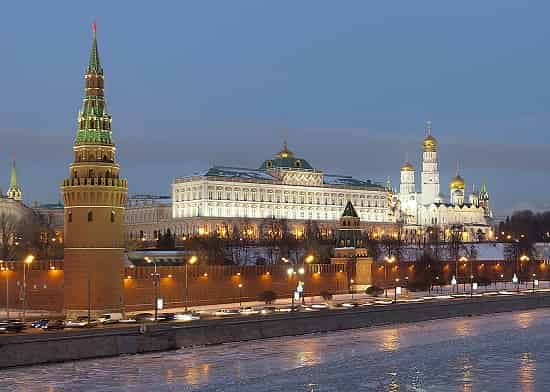
Russia has a long history of issuing coins commemorating sports events
In 2013, the World Summer Universiade was hosted
by Russia in Kazan, in the Tatarstan region of the country. To commemorate the event, Russia minted two different types of 10 rouble coins, as well as gold and silver coins with a mintage of up to 7,500 in number. As the Russian Federation was created only in 1991, earlier issues of sports-related coinage is attributed to the erstwhile Soviet Union. In fact, the Soviet Union also had a long tradition of minting commemorative coinage in order to mark major international sports events. Coins were issued to celebrate the Moscow Olympics in 1980. Copper and nickel one rouble coins were issued with mintage quantities of up to 9 million from 1977 to 1979. These coins featured images of famous Russian landmarks like the Mir space station and the Kremlin. Many coins were also minted by Russia for the Sochi games, including the country’s first ever 100 rouble banknote. Interestingly, days before the break-up of the Soviet Union, coins were minted to commemorate the Barcelona Olympic Games with a mintage volume of 250,000. However, these coins were never formally issued.
2014 World Cup coins
During the last World Cup in 2014, FIFA had launched a massive programme to officially issue coins and medals. The programme enjoyed participation from most football playing nations across the world. All of these countries minted commemorative coins, which were despatched to collectors in its official packaging. This featured a white case that had the embossed World Cup logo on the lid. The coins were packed in protective capsules to prevent damage.
Contact Physical Gold for the best advice on how to buy coins
Our numismatics experts can give you sound advice on how to buy coins made of precious metals. Call our team on 020 7060 9992 or get in touch via our website, and a member of our team will be in touch with you at the earliest.
Image credit: Wikimedia Commons
The Royal Mint launched a unique series of coins in 2016, known as the Queen’s Beasts. Statues of the Queen’s Beasts were present at the historic occasion of the coronation of Queen Elizabeth II, Britain’s current and longest-reigning monarch. The event took place on the 2nd of June, 1953 at Westminster Abbey in London. The coins were minted in silver and gold. There are 10 planned coins in the series, featuring stylised images of each of the Queen’s Beasts statues from the 1953 ceremony. The designs of the coins were developed by Jody Clark. The series is significant, as it is the first time that the UK has issued a two ounce silver coin, which forms part of this series. In this article, we will explore each coin in detail.
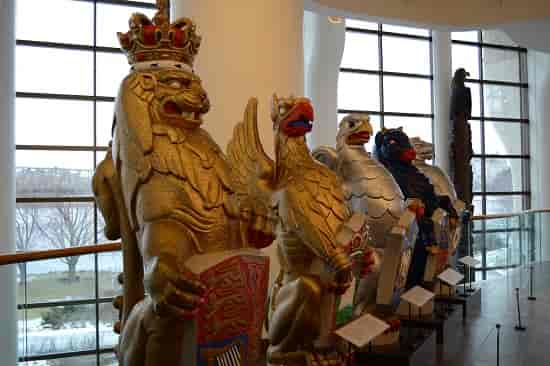
The Queen’s Beasts are a series of statues depicting mythical figures that form part of British pageantry
The Lion of England
The Lion is the first in the series that was inaugurated in March 2016. The issue was completely sold out on allocation. A further mintage was issued by mid-June 2016. The coins were delivered to investors packed in a protective plastic capsule. The obverse of the coin displays a portrait of the Queen, similar to the ones issued on other coins. The obverse also contains the inscription ‘Grace of God, Defender of the Faith’, written in Latin. This is displayed in an abbreviated form with the letters DG REG FD. The initials of the designer, Jody Clark are also inscribed. The reverse is the side that features the stylised version of the crowned Lion of England. The reverse also shows the name of the statue, the fineness of the coin, the year of issue and the signature of Jody Clark.
Interested in buying gold or silver coins? Download our FREE 7 step cheat sheet here first
The Griffin of Edward III
The Griffin was issued in November 2016 and is the second coin in the series. Once again, the obverse features a portrait of the Queen and the initials of the designer. The reverse has the stylised image of the statue of the Griffin, along with the inscription, ‘Griffin of Edward III’. The text also indicates the fineness, year of issue and the signature of the designer.
The Red Dragon of Wales
Riding on the success of the first two issues, 
The Unicorn of Scotland
The fourth release of the series came in September 2017. In doing so, the Royal Mint skipped a release in March earlier in the same year. With the obverse, identical to the other coins in the series, the only difference was the finish. The earlier coins had a stucco style finishing for the obverse, however, this time the finish featured an arched pattern of several tiny diamonds.
The reverse of the coin features an image of the Unicorn of Scotland along with similar inscriptions and the initials of Jody Clark, the designer.
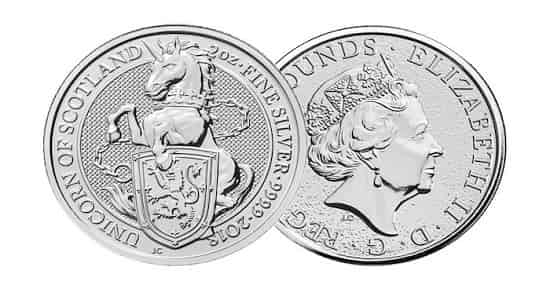
The Unicorn of Scotland is the fourth coin in the Queens Beasts series
The Black Bull of Clarence
The fifth in line of the Queen’s Beats series is the Black Bull of Clarence, which was issued in March 2018. The obverse is the same as the other coins and the reverse features an image of the black bull, with the other inscriptions similar to the earlier coins in the series.
White Horse of Hanover
The White Horse Beast celebrates the rule of King George I, the first monarch from Hanover to rule Britain in 1714. His ascension to the throne came as he was the closest living Protestant relative to Queen Anne. He was the grandson of Elizabeth Stuart, sister of Charles I, and in fact ruled the whole of Britain, France and Ireland. The Haus Hanover lineage stemmed from the House of Brunswick-Luneburg, rulers of the pre-republic Duchy of Brunswick.
Falcon of the Plantagenets
The reverse of the coin features the impressive Falcon of Plantagenets design, The falcon perches on a shield depicting another falcon sat on a fetterlock. Representing the House of Plantagenets, the falcon has long been a heraldic symbol of not on this famous royal house but also houses of York, Lancaster and Tudor.
Yale of Beaufort
Like many of the 10 heraldic beasts, the Yale of Beaufort is a mystical beast with a number of slightly varying interpretations of the fable. The generally accepted parameters are that the Yale is a goat-like creature which boasts incredible powerful horns which can pivot in any direction for combat. It also possesses a set of boar-like tusks. The back of this 1oz coin features the legendary Yale of Beaufort, proudly astride a shield with crown and chained portcullis. The wonderfully detailed main image pops out even more as it sits on a dimpled background, adding depth. Around the edge of the image is the wording ‘YALE OF BEAUFORT’, coins weight ‘1oz’, ‘FINE GOLD’, purity ‘999.9’ and finally the year of issuance.
White Lion of Mortimer
Not to be confused with the Lion of England emblem, also celebrated in the Queen’s Beasts coin range, the Lion of Mortimer features no crown and its tongue and claws are blue rather than red. Originally inherited from his grandmother, heiress of the Mortimers, it was Edward IV (1461-1483) who first used the Lion of Mortimer in the Royal Arms. Representing his House of York, the Lion design holds a blue shield with white rose on a golden sun. The symbol has since been favoured by King George VI, Queen Elizabeth’s father.
See the 1oz Gold Lion of Mortimer here.
White Greyhound of Richmond
The White Greyhound is associated with the Tudor era, in particular Henry VII and his father Edmund Tudor. The Greyhound symbolised the Honour of Richmond, which Edmund used as Earl of Richmond.
Completer coin
The coin celebrates the success of the 10 beast series by featuring each of the previous beasts surrounding and protecting Queen Elizabeth, as the original statues were designed to do.
As with the core 10 beasts, the Completer coin is issued in the 1oz Gold version and the 2oz Silver bullion coin.
Call us to know more about investing in precious metal coins
Our investment experts include numismatics specialists who can guide you on the right ways to buy gold and silver coins. Bullion coins can be an excellent investment, whether you’re an investor or a keen numismatist. Queen’s Beasts coins are available at Physical Gold and come with a certificate of authenticity. Dial 020 7060 9992 to talk to a member of our team, or email us to avail of the right advice in buying gold and silver coins.
Image credits: Money Metals and Wikimedia Commons
The price of silver has skyrocketed over the years and silver coins are now worth a lot of money. When we look at British coinage history, we realise that coins minted after 1947 contain no silver and therefore aren’t that valuable. These pre-1947 coins are now worth more than 40 times in value, depending on their silver content and their rarity. In general, any coin that was coined before 1947 is worth a lot more than its face value. For example, coin dealers do offer a pound for a sixpence coin minted before 1947. However, in this article, we will look at the silver coins made before 1947 that’s actually worth looking for and collecting.
“Should I invest in gold or silver?” – enjoy our YouTube video.
Valuable old British coins
Pre-1920 silver coins are made using 92.5 % real silver and the ones made from 1920 to 1947 had 50% silver. These coins can, therefore, be sold as bullion. A good starting point in identifying dealers is to check out the British Numismatic Trade Association (BNTA).
Here’s a list of 6 great British silver coins from yesteryear that are valuable and boasts of fine grade silver.
- A George III Crown is a great coin to have in your collection. These coins could date back to 1818 and normally weigh 28.27gms of 0.925 fine grade silver.
- George IV Crowns date back to 1821 and were also minted with 0.925 fine silver. These coins weigh 28.27gms and can get you £26 to £35 depending on their condition
- The 1892 ‘Jubilee Head’ Florin features Queen Victoria on the obverse and weighs 11.4gms of 0.925 fine grade silver. Only 283,000 were minted and these usually fetch nearly £120 in the market.
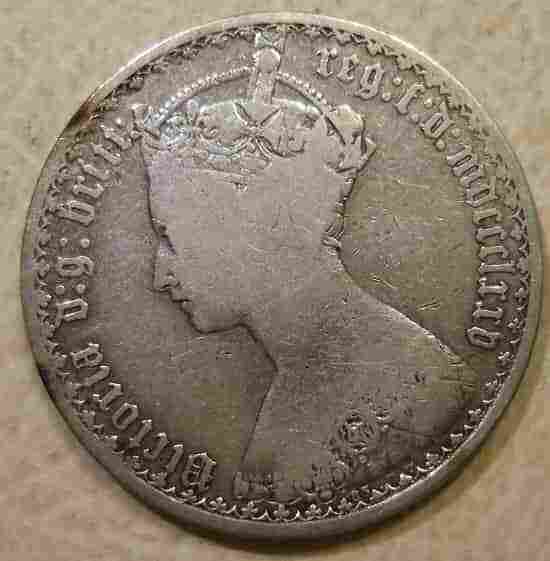
The Victorian Silver Florin dates back to 1875 and is a highly collectable coin
- The 1902 Edward VII British silver shilling is yet another collectable coin of value. These were issued only till 1910 and weighs 5.25gms of silver with purity of 0.925. Almost 7.9mn were coined at the time and many are still available. So, it’s worth looking out for one as each of these in a good condition could fetch around £100 in the market.
- 1743 George II Shilling Roses is a highly collectable British silver coin. The shilling commanded a value of 12p at the time and was struck using silver mined in Britain itself from the West of England and Wales. The obverse features the profile of King George II and the reverse is adorned by the roses and plumes, symbolising the origin of the silver. A fine specimen of one of these coins could fetch around £
- The 1847 Silver Proof Gothic Crown is considered by many numismatists around the world to be the finest silver coin ever minted. The inscriptions on the coin are in gothic script, hence the name. Queen Victoria is pictured with a crown on this coin. As these were minted as a proof, they were not circulated. Nevertheless, these coins are part of many coin auctions across the world and a good quality one could be worth around £
Numismatics experts at Physical Gold can help you select the right silver bullion
At Physical Gold, we have a team of expert numismatists who can help you make the right investments in British silver coins. Although many of these coins aren’t necessarily priced in thousands, they are sure to get steadily dearer with the passage of time (e.g. like modern-day Sovereigns and Britannias). With silver prices steadily climbing, and the rarity and collectable value of these coins increasing, now is a good time to invest in British silver coins and hold them for the long run. Call our team on 020 7060 9992 or email us to find out more.
Image credit: Wikimedia Commons
Silver 1kg Kookaburra
- This coin weighs 1002.502g and is produced in 999.0 Fine Silver.
- The coin is minted and supplied by The Perth Mint, Australia.
- Finished to bullion standard.
- Dimensions: Diameter: 101.00 mm. Thickness: 14.60mm.
For silver investors looking for an interesting alternative to British bullion coins, the Australian silver kookaburra coin represents the perfect investment. This one of a kind silver coin is produced by the Perth Mint and celebrates one of Australia’s most charming birds. Produced in 99.9% pure silver, Australian silver kookaburra coins are classified as legal tender in Australia and have a face value of 30 Australian dollars.
Due to being backed by the Australian government, they are considered to be a relatively secure investment and hold great investment appeal to investors who want to purchase a coin with a guaranteed silver content. The first silver kookaburra coins were issued in 1990 and since then they have become a favourite among many collectors. They are the longest-running bullion program currently issued by the Perth Mint.
The kookaburra
The kookaburra is a beautiful bird and the largest member of the Kingfisher family. They are native to both Eastern/Southern Australia and well known for their distinctive song which is said to sound like human laughter. They are incredibly protective birds and have been known to fight tenaciously to defend their nests. Kookaburras thrive in a range of habitats as diverse as humid forest to the savanna dessert. They are also known to populate suburban areas with tall trees or near running water.
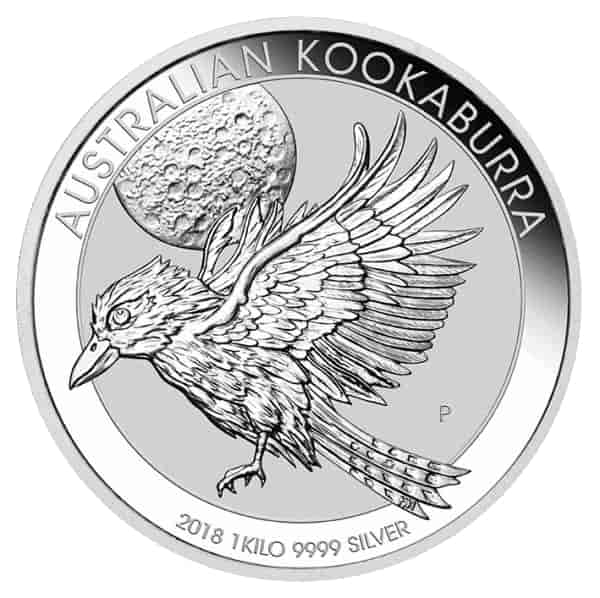
The 2018 Kookaburra Silver coin
The design of the Silver Kookaburra coin changes every year. The one exception was in 2015 when that year’s coin featured the same image as the original 1990 edition in order to commemorate the 25th anniversary since the first coin in the series was minted.
The 2018 1 kg Silver Kookaburra coin features a detailed image of a Kookaburra on one side, and the Ian Rank-Broadley effigy of Queen Elizabeth II on the reverse. The design of the Silver Kookaburra coins varies from year to year with this years’ design depicting an image of the bird in full-fight with the full moon in the background. The coin also features the Perth Mint’s “P” mintmark. This years’ edition differs from previous editions as the coin has been upgraded to a purity of .9999 silver. Previous editions up until the 2018 issue only had a purity of .999 fine silver.
Why invest in the 1kg Silver Kookaburra coin?
1 kg silver coins are an ideal option for investors who want to  purchase silver bullion in slightly larger quantities as it is often cheaper to buy one large coin rather than several smaller ones. It is also more convenient storing several larger coins as opposed to a collection of smaller ones.
purchase silver bullion in slightly larger quantities as it is often cheaper to buy one large coin rather than several smaller ones. It is also more convenient storing several larger coins as opposed to a collection of smaller ones.
Our 1 kg Kookaburra coins are sourced directly from the Perth Mint, so you can be sure of their authenticity. The unique nature of the Silver Kookaburra coin as well as its intricate design, makes it a perfect coin for bullion investors and coin collectors alike. They are also recognised by traders all over the world, meaning you will have no problems should you ever need to find a buyer. For coin collectors interested in nature or who want to own something uniquely Australian then the silver kookaburra coin would make a great addition to your portfolio. They are produced in much smaller numbers than other bullion coins such as the Canadian Maple Leaf or American Eagle, and the 1kg edition is particularly rare.
Contact Physical Gold for further advice
Do you want to buy a 1 kg Australian silver Kookaburra coin, then look no further than Physical Gold, we are expert suppliers of coins and precious metals. For advice simply call us on 020 7060 9992 and we will be glad to help!
Whether you’re a serious or hobby numismatist, or an investor looking to build your wealth, silver coins can be a great investment. Currently, market analysts have become increasingly bullish on silver as an investment option and the future looks bright for the precious metal. Interestingly, silver investment with its significantly lower price parity when compared to gold, offers investors a great gateway to building a precious metals portfolio at a fraction of the price of gold.
Download the FREE Silver coin Investment Guide now
Can silver be supplied VAT free?
For many years, Physical Gold Limited supplied VAT free. Due to an EU Treaty, this was legal and possible, but sadly Brexit brought this to an end and VAT free silver is no longer a possibility.
Brexit ended VAT free silver, but thankfully we are still able to sell popular silver coins and bars at all-in competitive prices. This is enabled due to:
- Free delivery – we are now shipping silver directly from the UK, this means we can provide silver with free delivery (this was not previously possible).
- Reduced product range – additionally, we decided to reduce the number of silver products we offered. Although, this may be worse for choice, it means we can bulk-buy the products we choose and negotiate much better prices – this discount is passed on directly to you!
Silver great for balance and protection
Savvy investors always turn to precious metals in order to hedge their risks and silver is an excellent choice for this purpose. In fact, historically, silver has always been a popular choice for coinage across the world.
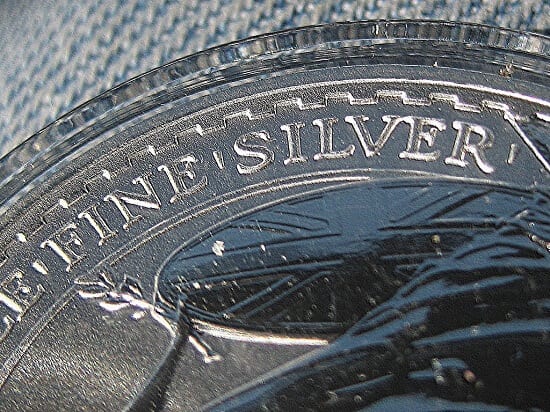
Examining the accuracy of ridges on the sides of a silver coin can establish its authenticity
Why is silver used to make coins?
Silver is a popular metal for coinage, owing to its fungibility. 
Apart from this, the other reasons for the popularity of silver for coinage are that silver is compact, easy to store and move and its density ensures that small quantities of the metal have high value. It is very durable and does not corrode easily. In addition to these factors, the metal is easily transformed from bars to coins and vice versa, through melting.
Silver coins are a popular investment option since storage is easy owing to their size. Like all other coins of numismatic or bullion value, they come packaged in their slabs. Buyers should always check that the slabs are intact at the time of delivery. Not only does this indicate that the coins have not been tampered with, but they also need to remain in their packaging in order to retain their value. Coins removed from their slabs can fetch a lower resale price, and it’s important to know this before investing in silver. As a silver buyer, it’s important for you to know certain facts about investing in silver coins before making your purchase.
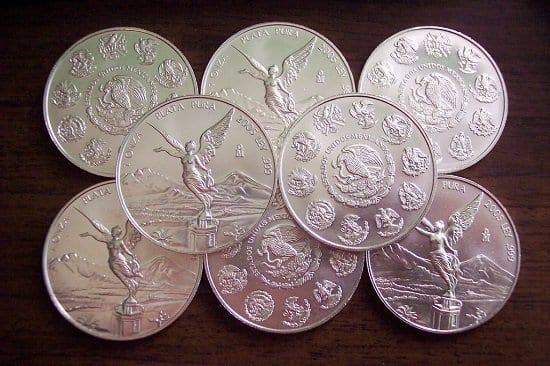
Sets are popular with numismatists. Here is a set of 1oz Libertad de Plata from Mexico
Checking authenticity
Upon receiving your silver coins from your dealer or the mint, you need to first establish the authenticity of the coins. Of course, if it’s arrived along with a certificate from a reputed dealer, and you’ve already verified the seller, simply retain the coins in their packaging. But let’s assume you’ve bought them at an auction. Then, you need to ensure that the coins are legit. There are many ways to do this. There is a device called the Fisch tester which ascertains the actual age of the coins by testing them. These tests are based on weight and dimensions. An alternate method is to check the conductivity factor. As silver is a great conductor of heat, placing an ice cube on a coin will likely see the coin melting fast as the heat is transmitted to the coin.
Buying silver coins from Physical Gold
The process of buying silver coins from Physical Gold couldn’t be easier. All you need to do is open an account online. Next, you need to browse through the site and add the silver coins (such as Britannias) of your choice to your basket. Once you’re done, you can simply check out using your credit or debit card. Your transaction is protected by our 3D secure authentication process.
Remember, coins and bars cannot be clubbed together, and you will need to purchase them separately, although you can speak to us about pricing for bulk purchases. Your coins will then reach your address via a courier service that is completely insured to protect your investment. If you need guidance at any point in time, all you need to do is call us on 020 7060 9992 or email us. A member of our helpful team will be in touch with you right away. Happy investing!
Image credits: Eric Golub and Christian Fausto Bernal
All collectors, irrespective of whether they’re philatelists, sigillographers or numismatists, require certain accessories to store or display their collections. While investing in bullion is not the same as numismatics, investors who have purchased gold coins require protection for their assets. A range of accessories is available to store your gold coins safely, as well as ensure that the coins do not get damaged in any way, thereby reducing their value. www.physicalgold.com understands the requirements of gold and silver coin investors and have a range of useful and stylish accessories that you can choose from.
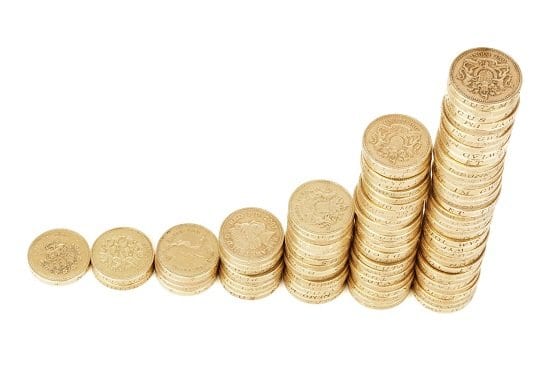
Coins need to always be stored in capsules to prevent damage
Coin capsules
Acrylic coin capsules are a great way to store your valuable 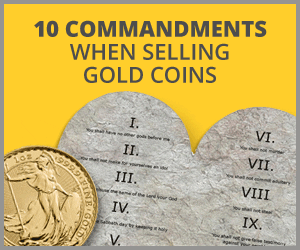
Storage accessories
Storing your gold at home can always be a risky business. Homes usually do not have the failsafe security devices that can be found in a bank or a secure storage vault facility. Your home is always vulnerable to a break-in by burglars. In the event of such a calamity, your precious metals are always at risk. In order to safely conceal them in your own home, it’s important to invest in innovative storage solutions for your home that can store your precious metals safely away from being discovered by criminals. An excellent solution is the secret stash wall clock. It looks just like an ordinary wall clock but opens up and has a storage compartment inside to store your gold coins, bars and jewellery.
So discrete, it looks like part of the wall!
Yet another innovative hidden storage solution is the wall socket hidden storage. It looks exactly like a standard UK electrical plug socket on the wall but opens up to reveal a deep cavity in which your bullion can be safely hidden away. These practical, yet clever storage accessories are unique and great as they conceal your precious metals right under the very nose of the burglars. So, while they’re searching for drawers, cupboards, walls and floorboards, they don’t realise that your valuables are in a very visible place. Lastly, there’s the lockable cash box, which is a great storage solution, although it isn’t a concealed one. Once you’ve put your precious metals in the box, you have to find a safe place to hide it.
Luxury presentation cases
At www.physicalgold.com, we have quality presentation cases that come along with acrylic coin capsules. The cases are primarily for storing full or half gold sovereigns and can accommodate 10 coins in each case.
Call us to find out more about coin accessories
Our team consists of coin experts who can advise you on the best way to store your coins so that it stays in mint condition for years to come. Please call us on 020 7060 9992 or get in touch online to speak with a member of our team.
Image credits: Pixabay
Mintmarks are small indentations that have been stamped onto a coin to show from which mint it has been produced. They were originally introduced so that if there was a problem with a coin – i.e it was underweight or contained less metal than specified, then the owner could tell exactly which mint was responsible. In other words, a mintmark is a guarantee or mark of authenticity to prove that a coin has been produced exactly as has been specified.
Mintmarks throughout history
The first mintmarks were produced by the ancient Greeks and were known as Magistrate marks. At the time Magistrates were among the top-ranking government officers in Ancient Greece and were responsible for the production of coins. The magistrate mark symbolised the name of the magistrate who had overseen the production of that particular coin.
Proof of origin
The ancient Romans also used marks to determine from where a coin was produced, and mint marks were a regular feature of Roman coinage. Often these marks could be found at the bottom of the reverse side of a coin and contained three parts. The name and location of the mint and the workshop contained within the mint.
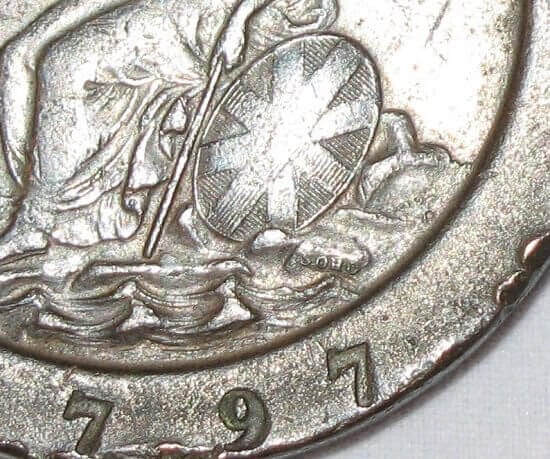
An example of a Soho mintmark on an old British Cartwheel Twopence
The importance of mintmarks for coin collectors
Certain collectors who display an interest in numismatic coins take particular interest in mintmarks. Sometimes it can make a huge difference in the value of a coin and knowing what makes certain mintmarks more collectable and where to locate them is part of what makes a coin collecting such an exciting pastime. A rare mintmark mark can add thousands to the value of a coin.
British Mintmarks
The Royal Mint has been responsible for minting coins 
What’s the story with modern coins?
One defining factor of the Royal Mint is that it doesn’t often use a mintmark for British coins. For example, gold Sovereigns that are minted in the UK feature no mintmark at all whereas sovereigns that have been minted in branch mints overseas all feature their own unique lettering to represent where they have been produced. For example, sovereigns minted in Sydney feature the letter S, Melbourne M, Perth P, Ottawa C and so forth.
Purchasing gold and silver coins through Physical gold
Physical Gold is one of the leading dealers of gold and silver in the UK. We offer investors the chance to invest in a wide range of gold and silver coins including our huge selection of gold Sovereigns. For more information or any additional advice on how to invest in gold and silver, please give us a call on 020 7060 9992.
Image Sources: Wikipedia

